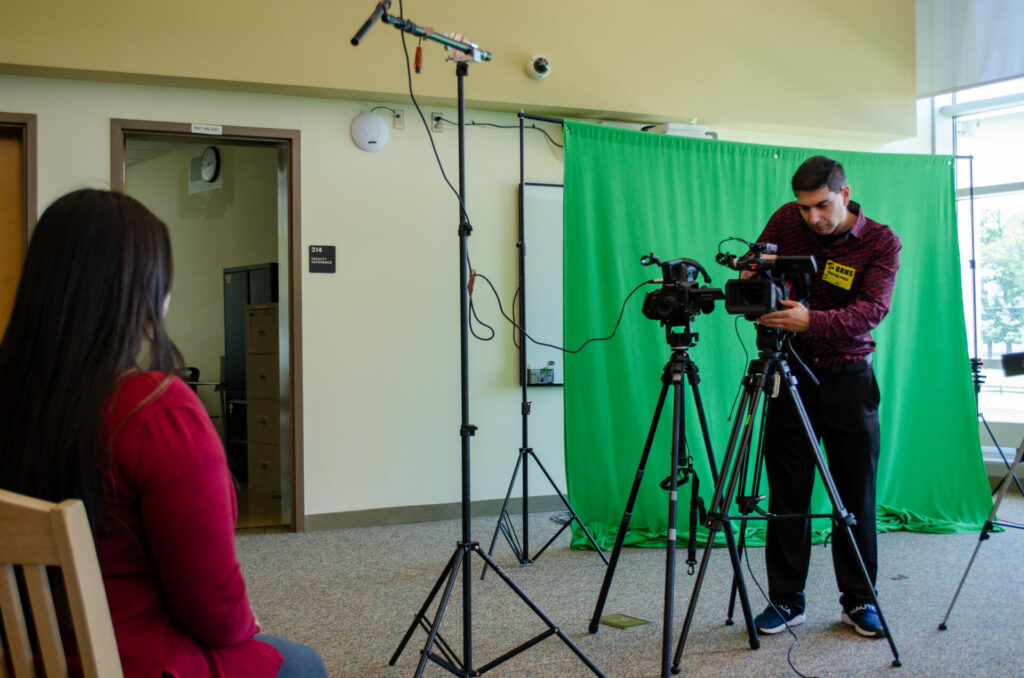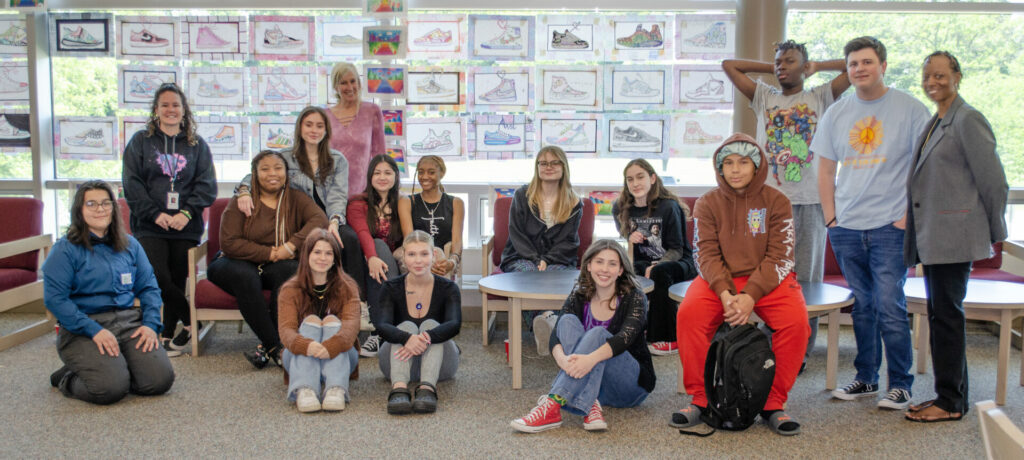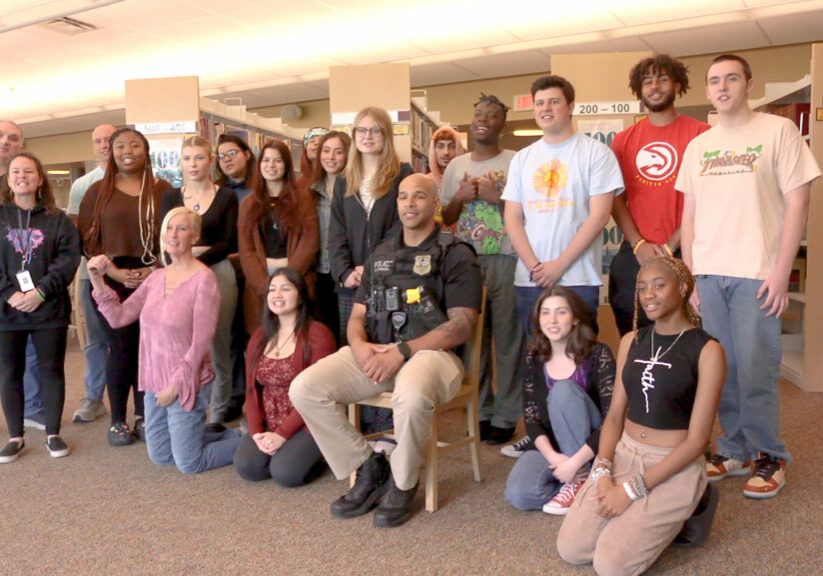The fight against addiction
By Sharon Milano
The fight against opioid and alcohol addiction has brought Bordentown Regional High School (BRHS) students and first responders together to collaborate on a comprehensive grant project called Bridging the Gap. The addiction and recovery grant provides Narcan training for first responders in Burlington County. To put a human face on addiction, videos featuring interviews conducted by BRHS students have become part of the training.
The project started with Nell Geiger, a student assistance counselor (SAC) and adviser to the BRHS Peer to Peer club, and Brandy Mullin, project director of the First Responders Comprehensive Addiction and Recovery Grants for Burlington County. They teamed up to create a video to raise awareness about the vast extent to which addiction affects members of a community. The video would also highlight the need to educate first responders in ways to provide support for individuals who have substance use disorder.
“The grant came about because the Substance Abuse and Mental Health Services Administration (SAMHSA) saw the need to link first responders with individuals who have a substance use disorder,” Mullin explains. “This is especially true after they receive opioid reversal medication, such as Narcan, when somebody is experiencing an overdose.” SAMHSA is a federal agency within the U.S. Department of Health and Human Services. According to its website, SAMHSA envisions that people with, affected by, or at risk for mental health and substance use conditions receive care, achieve well-being and thrive.
In other words, the project bridges the gap between those struggling with addiction and those trained to save them from an overdose. It also recognizes the impact addiction has on loved ones and the need for continuing support for all affected.

NJEA staff member Chris Curto films a student during a video proclaiming that despite the challenges of substance use disorder, there is hope.
Addiction does not discriminate
Mullin’s passion for this project is driven by her firsthand experience with addiction and recovery. Since 2017, she has been a peer recovery specialist. She and her fellow peer recovery specialists have been successful in their own recovery and want others to experience the freedom from active addiction.
“Opioid addiction does not discriminate and has greatly impacted communities, families and first responders,” Mullin explains.
According to Mullin, the primary goal of the project is to humanize individuals who do have addiction because they are often thought of as just “that addict.”
“We don’t think of people with substance use disorder as who they really are: somebody’s mother, brother, father, sister, uncle,” Mullin says. “It also helps the first responders see why it is important to help these individuals, because not only are they serving their community, but they’re serving the children of their community too.”
Mullin only recently began working in Burlington County and wanted to work with BRHS, she asked a colleague for the name of someone who was passionate about helping others with substance use disorder. This is how she met Nell Geiger, who eagerly lent her support.
“In order to decrease the impact, we need to work together and bridge the gaps,” Mullin says. “Only when we can equally share the weight can we start to heal as a community.”

BRHS Peer to Peer Club members with student assistance counselor Nell Geiger (back center) and Brandy Mullin (second from left), project director of the First Responders Comprehensive Addiction and Recovery grants for Burlington County.
Peer to Peer Club provides safe space
The BRHS Peer to Peer Club began about 10 years ago and currently meets once a week during lunch and study hall.
“As a psych counselor, I get to advise teens who come and talk about real teen topics in a safe place,” Geiger says. “It’s confidential. For anything kids want to talk about, they can connect with each other about mental health issues, substance use, substance use in the family, stress and anxiety.”
Geiger adds that club members take what they learn and the coping tools they’ve established to younger grades. Geiger noted with sadness that many students are impacted by addiction.
“This year we’ve been teaching the fifth graders about a lot of different coping techniques,” Geiger says.
Geiger notes that she can relate to the students because she grew up with addiction in her own family.
“My mom was addicted to alcohol when I was growing up,” Geiger says. “It’s difficult to learn and to function when you have somebody at home who’s dying from an illness like alcoholism. I never had a person to talk to, so my role as a psychologist is near and dear to me. I can be here for kids, whether it be in a club, in a group or individual setting.”
Geiger says that she was glad to participate in the Bridging the Gap grant project because bringing the community into the schools is part of her job.
“I have a lot of connections with the county,” Geiger notes. “Burlington County Director of Alcohol and Drug Abuse Alfreda Francis thought it would be a great idea to have a student’s perspective on the film.”
Geiger reached out to students and invited them to get involved.
Messages of hope promoted in Bridging the Gap videos
Geiger described the importance of the students’ role as interviewers of people who are affected by addiction, including first responders.
“Some of our kids themselves have witnessed overdoses,” Geiger says. “Many of them have lost loved ones because of the opioid epidemic. Being able to interview the first responders who reverse an opioid overdose is like magic, and it gives that person another chance at life.”
Geiger says that it’s just vital for these responders to continue to receive addiction training.
“It is important to allow the kids to give their voice to this topic and to know that no matter what, no matter who’s affected by addiction, whether it be in their family or a friend, that there is hope, there is recovery, and they’re not alone,” Geiger says. “It’s so important that we continue to talk about the subject to reduce stigma so that they can seek and find help.”
During the opening minutes of the video series, students share affirmations as they let viewers know that they love, or have been affected by, someone with an addiction. Their message: “There is hope.”
Throughout the video’s interview process, it became increasingly clear that nobody, including first responders, are exempt from addiction.
Detective Wayne Woolverton from the Burlington County Sheriff’s Office discussed his 20-year addiction to drugs and alcohol starting at age 13. It left him feeling “depressed, hopeless and helpless.”
Woolverton considers himself to be fortunate, explaining that during times when he felt most desperate and unsure of a way out, “someone reached out to me and told me that it was going to be OK.”
“I’ve been clean for almost eight years, and I’m grateful every single day that I wake up,” Woolverton says. “I have my own home, my own car. I’m financially stable. I’m looked at as a good son, a good brother, a good uncle. At work, I’ve been promoted to detective. But the greatest thing recovery has done for me is that it’s given me meaning and purpose. And being able to help another human being out is the greatest gift of all. I’ve been able to do that because of recovery.”
In another interview, retired Willingboro Township police officer and current EMT instructor Jason Woodruff stressed the importance of peer-to-peer support for first responders. Woodruff described how having a background as a first responder is crucial for making personal connections when supporting other first responders with addiction.
“I think when you have that shared background, it makes that connection a lot more personal,” Woodruff says. “It helps the client deal with the trauma or the substance abuse or whatever other personal issues they’re having at that time.”
Woolverton and Woodruff’s sentiments were echoed by Burlington Police Chief John Fine, who explained that the role of policing is not only about law enforcement when dealing with individuals with substance use disorder. It’s also about rehabilitation and recovery for those affected.
“We see a lot of families that need help, and we’re trying to get them to rehabilitation to get the family unit back together,” says Fine. “We offer opportunities to make sure that we’re allowing families to heal and also supporting families that are going through this with their kids.”
Fine adds that training for law enforcement is necessary to make sure that police are helping the community they serve. According to Fine, both violent and petty crimes are often linked to drug use.
“If you’re able to help families come back together and are helping young people, you’re actually preventing crime,” Fine concludes.
Appreciative of widespread support
Both Mullin and Geiger expressed their appreciation for the widespread support they have received for the Bridging the Gap project.
“I’m really excited that Burlington County cares so much about their community members to take a chance on doing a video like this,” Mullin says. “It recognizes that the support is needed both for first responders and individuals who have a substance use problem.”
Geiger notes the importance of backing from the school district.
“We’re very fortunate here at Bordentown Regional High School,” Geiger says. “Our superintendent, Dr. Adkins, our principal, Rob Walder, and our board of education have all been incredibly supportive of our endeavors.”
Geiger believes it is of paramount importance for every school across New Jersey to have a student assistance counselor who can provide a place where students can seek support for mental health issues and have an assurance of confidentiality. The “Bridging the Gap” project poignantly demonstrates the urgent need for these counselors.
Sharon Milano is a fellow in the NEA Organizing Fellowship Academy. While in that role she is on leave from her positions as an NJEA Communications Consultant and as an eighth-grade social studies teacher at Franklin Avenue Middle School in Franklin Lakes. She can be reached at smilano@njea.org.
Watch the videos
NJEA Communications staff member Chris Curto worked with students and staff at Bordentown Regional High School to produce five videos as part of the Bridging the Gap project.
One video features testimonials from first responders and BRHS students and staff proclaiming that recovery is possible and that “there is hope.” These testimonials are followed by student-led interviews with EMT instructor Jason Woodruff, Senior Peer to Peer Club Coordinator Ashley Broecker, Burlington City Police Chief John Fine, and Burlington County Sheriff’s Office Detective Wayne Wolverton.
